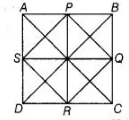The figure formed by joining the mid-points of the sides of a quadrilateral ABCD, taken in order, is a square only, if
(a) ABCD is a rhombus
(b) diagonals of ABCD are equal
(c) diagonals of ABCD are equal and perpendicular
(d) diagonals of ABCD are perpendicular
(c) Given, $A B C D$ is a quadrilateral and $P, Q, R$ and $S$ are the mid-points of sides of $A B, B C$, $C D$ and $D A$, respectively. Then, $P Q R S$
is a square.
$\therefore \quad P Q=Q R=R S=P S \quad$ .......(i)
and $P R=S Q$
But $P R=B C$ and $S Q=A B$
$\therefore \quad A B=B C$
Thus, all the sides of quadrilateral $A B C D$ are equal.
Hence, quadrilateral $A B C D$ is either a square or a rhombus.
Now, in $\triangle A D B$, use mid-point theorem

$S P \| D B$
and $S P=\frac{1}{2} D B$ ... (ii)
Similarly in $\triangle A B C$ (by mid-point theorem) $P Q \| A C$ and $P Q=\frac{1}{2} A C$ ... (iii)
From Eq. (i), $P S=P Q$
$\Rightarrow$ $\frac{1}{2} D B=\frac{1}{2} A C$ [from Eqs. (ii) and (iii)]
$\Rightarrow \quad D B=A C$
Thus, diagonals of $A B C D$ are equal and therefore quadrilateral $A B C D$ is a square not rhombus. So, diagonals of quadrilateral are also perpendicular.
